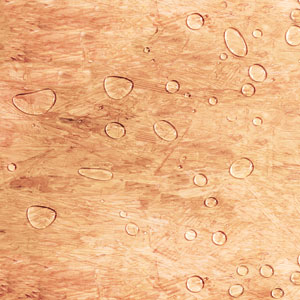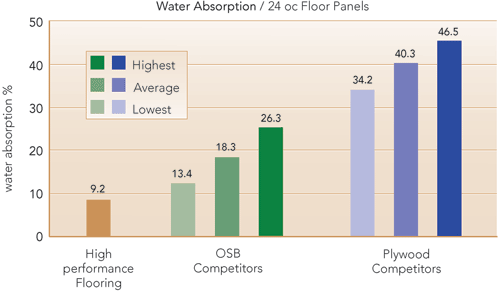The Makings of a Great Subfloor
Oriented Strand Board
Using 3-inch to 4-inch strands of wood that are also layered and configured in a crossing pattern, then glued and pressed, oriented strand board (OSB) is more dense than plywood and absorbs less moisture. Installation usually consists of gluing and nailing the OSB sheets to the floor joists. Typically, 3/4-inch-thick solid wood flooring is installed directly on top of a 3/4-inch-thick OSB subfloor, with hardwood floors at a 90-degree angle across the floor joists to stabilize and strengthen the whole floor structure. In cases where hardwoods are installed parallel with the floor joists, a second layer of plywood underlayment can be added to increase stability. Alternatively, blocking can be added between the floor joists. When installing engineered, solid, or floating floors that are less than 1/2 inch thick, manufacturers recommend an additional layer of 3/8-inch or 1/2-inch-thick plywood underlayment. The additional underlayment should be glued and screwed down over 3/4-inch-thick OSB subfloor to add stability. As an alternative 2 x 6 blocking can be installed between the floor joists for added stability.
When a roofless, partially built structure takes on water, both plywood and OSB can absorb water, which can lead to swelling and require sanding or replacement before finish flooring can be installed. Many consider OSB more structurally consistent than plywood, as it does not carry the delaminating issues that plywood does. On the other hand, traditional OSB can experience edge swelling when exposed to significant amounts of moisture. According to PATH, a public-private partnership for advancing housing technology, edges—particularly if they are cut edges—can expand by up to 15 percent. In addition, PATH notes that when plywood gets wet, it expands evenly throughout the panel, dries more quickly, and shrinks to its original size more rapidly than OSB.
Concrete Slab
Concrete slabs, which typically consist of a 4- to 6-inch-thick 3,500- to 5,550-pound per square inch (psi)-strength concrete pour, can be susceptible to moisture problems. Because water is used in mixing the newly poured slabs and can take several months to dry out, testing should be performed prior to installation of flooring finish. This can be as simple as taping the several sheets of plastic down in several areas of the slab, and waiting a few days. If moisture develops under the plastic, wood flooring should not be installed until the moisture situation is rectified. Depending on ground water levels, slabs can emit excessive moisture at different times of the year. It's worth noting that slab floors with plastic installed prior to the pour will be more apt to minimize moisture transfer.
It is not recommended that 3/4-inch solid wood flooring be nailed or directly glued down over a concrete slab as floor failure might result from moisture transfer. Alternatively, a “sleeper system” can be built over the slab using wood strips spaced 12 inches apart over which plywood can be placed. In another method, two layers of wood subfloor can be cross-layered diagonally over the slab. In any case, for best results, plastic should be laid down on the slab to retard any moisture transfer from the concrete. For a glue-down engineered wood floor over concrete slab, it is advisable to ensure that the slab has less than 4 percent moisture content year-round. A water-resistant adhesive should also be used.
 |
Advanced, moisture-resistant resins make water bead up, and not penetrate, high performance subflooring. |
High Performance Panels
High performance panels are engineered products with many of the same characteristics and qualities as OSB and plywood, but with distinct advantages. Developed to address the need for moisture-resistant subflooring, high performance panels are an enhanced OSB product, manufactured with a higher density of wood fiber and special resins integrated into the panel. These enhancements resist water absorption and reduce swelling common to traditional OSB subflooring. Specially engineered through advanced resin technology to resist water absorption, high performance panels minimize not only edge swell, but warping, cupping, and delaminating, thereby eliminating the need for sanding and costly rework. While typically the panels do not need to be sanded due to edge swell, some sanding may be required to ensure levelness of the floor system. Water repellent coatings are not recommended with high performance subflooring.
“Due to severe rain, floods, and snow this year, we have recently faced a very high moisture level in Kentucky. No matter what we tried when building with plywood, we had problems with the floor squeaking, delaminating, and swelling as a result of the moisture,” stated Builder Joe Pusateri of Elite Homes in Louisville, Kentucky. “In the past, we had to add a day into our building scheduling to repair the damaged plywood spots caused by the moisture-related issues. Once we began using high performance subfloors, we were able to remove that step in our building process, which saved us time in the long run to concentrate on other parts of the build and deliver the best possible living environment to the future homeowners.”
In addition to being moisture resistant, high performance panels are a more durable alternative to a traditional plywood or OSB underlayment. Through an optimal balance of density and advanced resin technology, the panels deliver greater stiffness and strength as well as superior nail holding capability. The flooring is available in 19/32-inch, 23/32-inch, 7/8-inch, 1-inch, and 1 1/8-inch thicknesses, and install and remain flat.
Like plywood and OSB, high performance subfloors represent an excellent substrate for a variety of floor coverings including carpet, tile, and hardwood flooring. Wood flooring is glued or nailed directly to the high performance panels or applied after in conjunction with other wood flooring underlayment materials. Architects should note, however, that moisture contents are critical when installing hardwood flooring. Ideally the inside of a home should be HVAC controlled to help with acclimation of the wood products at the time of hardwood flooring installation. To reduce the chances of buckling, cupping, and gapping of the hardwood flooring, the moisture content of the subfloor panels and hardwood flooring should be less than 12 percent before installing hardwood flooring, and ideally the difference in moisture content between them should be within 4 percent. Manufacturers recommend a pin-style moisture meter or similar should be used to determine moisture content of both the high performance subflooring and the hardwood flooring.
 |
All testing was conducted by an independent IAS accredited testing facility in September 2008. This small sample testing wasdone in accordance with the applicable ASTM standards and test methods. OSB values are based on lowest, average and highest water absoption levels of four manufacturers. Plywood value is based on the lowest, average and highest water absorption levelsof three manufacturers. Testing samples correspond to single manufacturing locations from one production date. |
Ceramic tile floors can be particularly challenging as they do not tolerate any type of movement within the subfloor without cracking. With less deflection than plywood or OSB, high performance panels can be a better subfloor option for ceramic tiles. However, ceramic tiles should not be installed directly over high performance panels; an approved underlayment must be installed prior to tile installation. The Tile Council of America Handbook for Ceramic Tile Installation should always be consulted for acceptable methods of tile installation on structural panel substrates.









